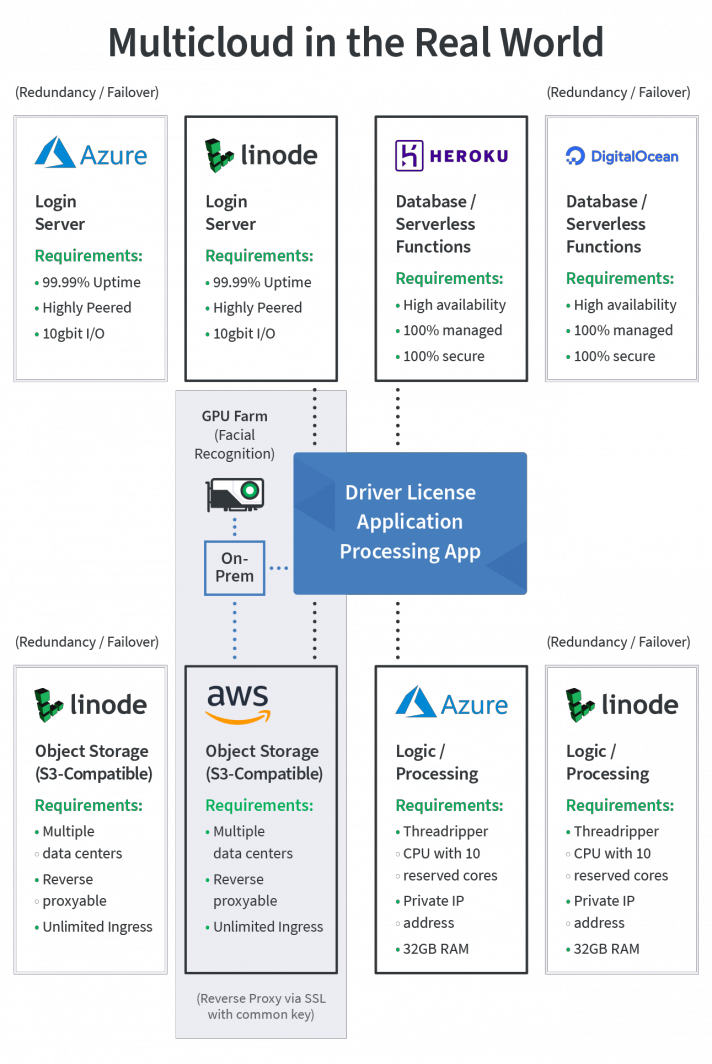
Why choose multi-cloud: Flexibility, cost, and risk avoidance
From flexibility to failover protection, there are many reasons why enterprises choose a multi-cloud strategy.
According to IDC statistics, more than 93% of companies have begun to use multiple cloud infrastructure platforms in their business operations. The majority of these companies (62%) reported taking this approach to better leverage the best capabilities of different cloud providers. For example, perhaps one cloud provider offers superior data archiving services, but another provider may be better at application hosting services with predictable usage.
Extend reading to learn about Akamai cloud-computing
A new choice for going to the cloud, a strong force in going global
Another reason why many enterprises choose a multi-cloud strategy is cost optimization. According to IBM statistics, 66% of users said that it is cheaper to cooperate with a small cloud service provider than to cooperate with a large cloud service provider that provides a large number of functions (even functions they do not need). In addition, although some large cloud service providers offer exclusive discounts, cost savings can also be achieved by migrating workloads to more specialized platforms.
Multi-cloud adoption creates new opportunities and reduces certain risks in key areas , such as vendor lock-in. A Flexera report mentioned that 68% of CIOs are concerned about the risks of using tools from a single vendor and lacking the freedom to move data on demand. Multi-cloud architectures can help companies avoid lock-in, and are more attractive to smaller businesses because they can start with a small technology stack and then scale the entire technology stack as business needs change. .
A multi-cloud architecture can also help mitigate other risks, which is even more important for companies that operate globally. Not all cloud providers can build data centers close to customers, which can lead to spikes in latency. In fact, 44% of IT decision-makers are still using on-premises solutions and have not migrated to the cloud due to concerns about delays in data transmission. But with the help of a multi-cloud approach, companies can smooth out latency issues by choosing different providers based on where their data centers are located and how close they are to where their business operations are . Whether you are a large global enterprise or a small company, you also need to consider factors such as availability, performance, data sovereignty, regulatory requirements, and labor costs. Gartner once believed that a multi-cloud approach makes it easier for enterprises to meet these requirements because multi-cloud can span more geographical locations and provide enterprises with richer choices.
Multi-cloud also solves a long-standing problem for many enterprises: putting all their eggs (data) in the same basket. After a failure occurs, it is undoubtedly best to be able to failover through backup. Likewise, suppose a cloud provider is acquired. In this case, the enterprise may face unanticipated "surprises" in which service terms or pricing may change, which may require a complete withdrawal from the platform currently used. In a multi-cloud ecosystem, migration can happen at any time because the enterprise has already found a "new home" for the workload.
The key to successful multi-cloud architecture
In theory, a multi-cloud architecture seems like an option that won't run into barriers. In reality, there may still be barriers between different providers' proprietary tools and prevent the seamless movement of data across different cloud platforms. Fortunately, enterprises can address these challenges through portability and strategic cloud management capabilities.

It is difficult for different providers to achieve consistency and standardization in terms of service features and functions , because even if different providers are compatible with each other, there will still be considerable differences. Logically, the more cloud providers there are to regulate and integrate, the more complex the ecosystem becomes and the greater the potential for things to go wrong.
Therefore, a key prerequisite for the success of a multi-cloud approach is the flexibility for users to move data and applications between different clouds.
User demands for portability place the onus on providers to provide a higher degree of support for portability, but the proprietary capabilities of different providers still create significant barriers between multiple clouds, limiting data or mobile application. In order to remove this barrier, enterprises must use open source technology to establish connections between different clouds. Developers can use such tools to build "vendor-neutral" customized applications (think of them as adapters or converters). This is compatible with non-modular tool implementations, thereby promoting portability.
Akamai + Linode join forces to become a new choice for enterprise multi-cloud
As a company established at the birth of the Web, Akamai not only invented the CDN (Content Delivery Network), but also operates an extremely complex global content delivery platform. Akamai has released many quality security and edge solutions over the years.
Linode was also an early pioneer in cloud computing. Linode was born in an apartment nearly 20 years ago and has now served customers in 185 countries and regions in 11 markets around the world. Years of operation have allowed Linode to gain the trust of millions of customers. With Linode's help, customers accelerate their innovation and build global products, allowing Linode to gain a firm foothold in the highly competitive market of cloud computing.
After Akamai completed its acquisition of Linode, magical things started to happen:
There is a natural complementarity between Akamai and Linode, which is not only reflected in the mission and culture of both parties, but also in their respective technical advantages. Combining Linode's compute and storage products with Akamai's serverless, CDN and security solutions will provide customers with a broader set of services to help them build, innovate and scale next-generation applications.
For example, Linode supports public distributions (rather than proprietary forks) of many open source software. The open API it provides allows developers to reuse existing code no matter which cloud provider they choose. Moreover, all development work of linode is completely open, and all documents are published to GitHub, where the entire community can improve and improve them. In this way, users maintain complete control over where their IT investments are deployed, which is where the true potential of a multi-cloud approach lies. And the driving force of this potential is becoming more and more powerful. 83% of multi-cloud users in IT organizations hope to obtain a more open ecosystem so that they can move workloads more "freely" between different clouds.
The new Akamai Linode will not only continue to provide free and live technical support services that are loved by many developers , but also has no plans to change its pricing strategy and will continue to provide simpler, more affordable, and easier-to-access cloud services for everyone. Whether you fell in love with Linode's service because of its reasonable pricing or predictable monthly bills, nothing will change.
Akamai Linode will launch a partner program to provide MSPs and other resellers targeting SMBs with a strong, fair alternative that won't be turned away by large cloud service providers because they don't have enough large enterprise customers. outside.
Conclusion: A multi-cloud future
Most enterprises that have dabbled in multi-cloud architectures have already seen returns on their investments. Michael Warrilow, vice president of analysis at Gartner, mentioned in a report: "We expect that most large enterprises will continue to deliberately adopt this approach." As the portability of cloud environments becomes increasingly enhanced, it will bring more benefits to users. Freedom of choice, more cost-saving opportunities, and greater data control.
If your enterprise is also considering joining multi-cloud deployment,
Click on the link below to learn about Akamai Linode’s solutions:
A new choice for going to the cloud, a strong force in going global
Linus took matters into his own hands to prevent kernel developers from replacing tabs with spaces. His father is one of the few leaders who can write code, his second son is the director of the open source technology department, and his youngest son is a core contributor to open source. Huawei: It took 1 year to convert 5,000 commonly used mobile applications Comprehensive migration to Hongmeng Java is the language most prone to third-party vulnerabilities. Wang Chenglu, the father of Hongmeng: open source Hongmeng is the only architectural innovation in the field of basic software in China. Ma Huateng and Zhou Hongyi shake hands to "remove grudges." Former Microsoft developer: Windows 11 performance is "ridiculously bad " " Although what Laoxiangji is open source is not the code, the reasons behind it are very heartwarming. Meta Llama 3 is officially released. Google announces a large-scale restructuring
